Today's dish is a meat and potato dish called nikujaga, which quite literally means "meat-potato." Fair enough. It's a popular home-style dish, and synonymous with Japanese comfort food.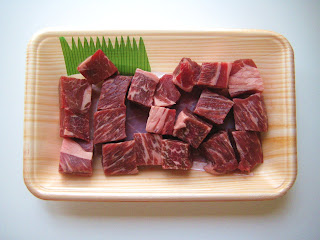 The traditional recipe calls for thinly sliced beef, like that used in sukiyaki. But I like large chunks... because why not. The beef I'm using here is prime chuck. You could easily make this dish with pork or chicken. The flavor won't change too much.
The traditional recipe calls for thinly sliced beef, like that used in sukiyaki. But I like large chunks... because why not. The beef I'm using here is prime chuck. You could easily make this dish with pork or chicken. The flavor won't change too much.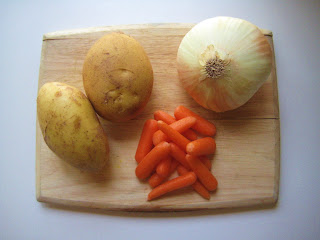 Our vegetables from left to right: 2 medium potatoes, 1 medium onion, a handful of baby carrots. They don't need to be baby carrots, I just had a bag of 'em lying around.
Our vegetables from left to right: 2 medium potatoes, 1 medium onion, a handful of baby carrots. They don't need to be baby carrots, I just had a bag of 'em lying around.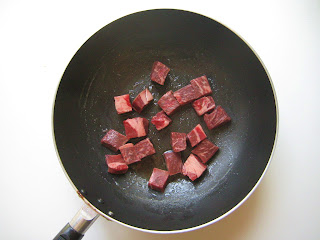 So we start by browning the beef over high heat.
So we start by browning the beef over high heat.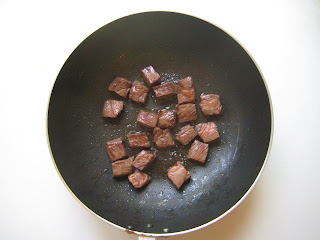 Just until they pick up some color.
Just until they pick up some color.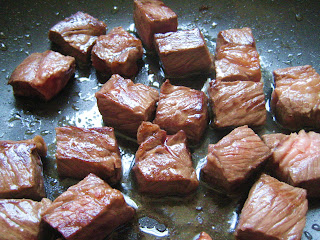 At this stage, the meat will still be around medium-rare.
At this stage, the meat will still be around medium-rare. Then we add our vegetables, chopped into bite-size pieces to match the beef.
Then we add our vegetables, chopped into bite-size pieces to match the beef.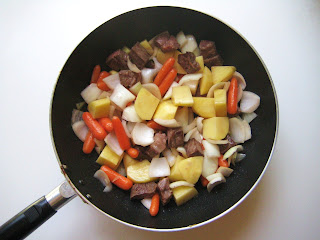 This is sauteed for around 5 minutes, just until the onion starts to cook.
This is sauteed for around 5 minutes, just until the onion starts to cook.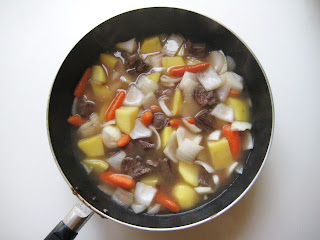 Then we add enough dashi broth just to cover. Here we are using about 2 and a half cups. Dashi is sold in most Japanese markets in a granulated form in packets, so making dashi broth really involves just adding water.
Then we add enough dashi broth just to cover. Here we are using about 2 and a half cups. Dashi is sold in most Japanese markets in a granulated form in packets, so making dashi broth really involves just adding water.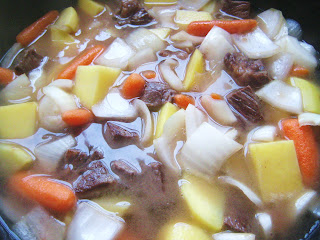 When this comes to a boil, the heat is turned down to around medium/medium-low, and we cover, and simmer for about half an hour, or until the potatoes soften. After which, we add around 2 tablespoons each of soy sauce and sake. Then we add brown sugar to our liking. Of course, the soy sauce and sugar can be substituted for bottled sukiyaki sauce. Same ingredients~ Sukiyaki sauce can border on the sweet side though, so balance it out with some salt, or more soy sauce if it's too sweet for your tastes.
When this comes to a boil, the heat is turned down to around medium/medium-low, and we cover, and simmer for about half an hour, or until the potatoes soften. After which, we add around 2 tablespoons each of soy sauce and sake. Then we add brown sugar to our liking. Of course, the soy sauce and sugar can be substituted for bottled sukiyaki sauce. Same ingredients~ Sukiyaki sauce can border on the sweet side though, so balance it out with some salt, or more soy sauce if it's too sweet for your tastes. Cook uncovered over low for another 8 minutes or so to reduce the liquid and cook the alcohol out of the sake.
Cook uncovered over low for another 8 minutes or so to reduce the liquid and cook the alcohol out of the sake.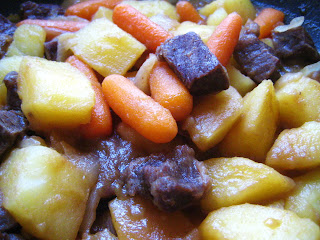 By now, the onions have dissolved, and, combined with the starch from the potatoes and reduced broth, forms a nice sauce. There's not too much sauce, but just enough to coat the meat and vegetables.
By now, the onions have dissolved, and, combined with the starch from the potatoes and reduced broth, forms a nice sauce. There's not too much sauce, but just enough to coat the meat and vegetables.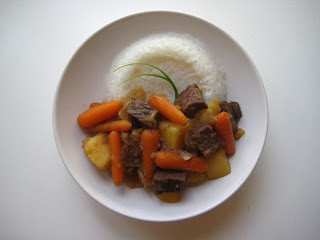 Served with some white rice, and this stew is Japanese comfort food at its best.
Served with some white rice, and this stew is Japanese comfort food at its best.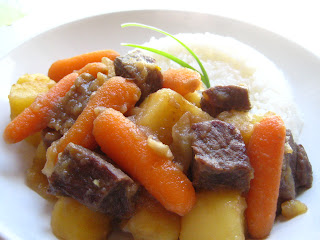 Nom.
Nom.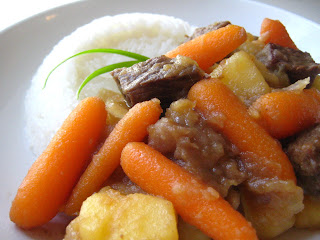 Oh, and no bonsai tree update today.... nothing's happened.... tear.
Oh, and no bonsai tree update today.... nothing's happened.... tear.
So the window that I thought was North facing was actually the exact opposite, meaning my bonsai is now DOOOOOOOMED. 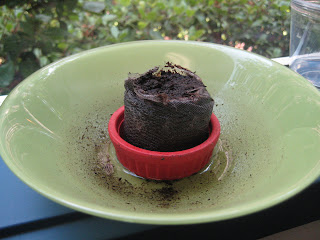 The window I moved it to now isn't North-facing either. It turns out there are no North-facing windows at all in my office. How sad. This window is at least next to my desk.
The window I moved it to now isn't North-facing either. It turns out there are no North-facing windows at all in my office. How sad. This window is at least next to my desk.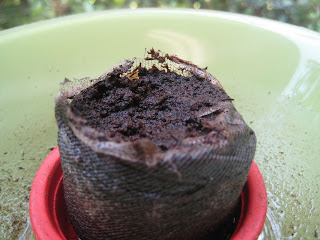 Anyway, a week in, and no sprouts yet. We'll see.
Anyway, a week in, and no sprouts yet. We'll see.---
So I've decided to make a couple Japanese dishes every weekend. Today's dish is sukiyaki, a style of nabemono, or "steamboat," the Japanese take on the hot pot, where thinly sliced meats are simmered with vegetables in a dashi broth.
Dashi is made by boiling together konbu, a type of edible kelp, and kezurikatsuo, shavings of dried tuna more commonly known as bonito. The resulting broth forms the base of many dishes, such as miso soup, noodle broths, and of course, nabemono soups.
Many consider dashi to be fundamental to Japanese cuisine. Shizuo Tsuji, author of Japanese Cooking, A Simple Art, writes, "many substitutes for dashi are possible, but without dashi, dishes are merely a la japonaise and lack the authentic flavor."
Thus, I was willing to bike 8 miles to a Nijiya Market to get some.
"Osen"-style sukiyaki comes from a great Japanese television series "Osen," which is about a traditional Japanese restaurant and its struggles in facing modernization. The way they prepare sukiyaki in the series is a step away from what I've seen before, but it was intriguing, so I thought I'd prepare sukiyaki today in that way.
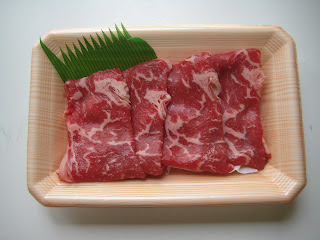 It starts with the beef. This is prime rib-eye, sliced thin. $19.99/lb at Nijiya Market. Expensive as balls, but I biked 8 miles to get there, so I figured what the hell.
It starts with the beef. This is prime rib-eye, sliced thin. $19.99/lb at Nijiya Market. Expensive as balls, but I biked 8 miles to get there, so I figured what the hell.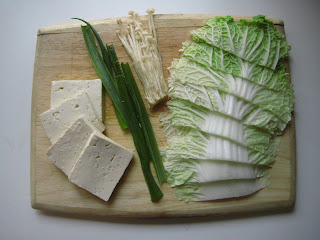 These are the vegetables that will go in later. From left to right: firm tofu, scallions, enoki mushrooms, and napa cabbage. In the show, they use just fried tofu and another vegetable called shungiku, which are garland chrysanthemum leaves. Traditional sukiyaki also uses this (as do many Chinese hot pot dishes), but I'm personally not a big fan, as they're relatively bitter.
These are the vegetables that will go in later. From left to right: firm tofu, scallions, enoki mushrooms, and napa cabbage. In the show, they use just fried tofu and another vegetable called shungiku, which are garland chrysanthemum leaves. Traditional sukiyaki also uses this (as do many Chinese hot pot dishes), but I'm personally not a big fan, as they're relatively bitter.
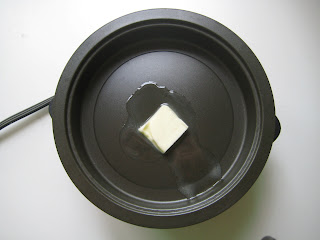 Here is where Osen-style sukiyaki differs from traditional sukiyaki, and also where I differ from Osen-style sukiyaki. In the series, they use a clay pot instead of a soup pot. I don't have a clay pot, so I'm using my mini-teppan grill. Also, rather than make the soup and cook the vegetables first, Osen-style sukiyaki browns the meat first.
Here is where Osen-style sukiyaki differs from traditional sukiyaki, and also where I differ from Osen-style sukiyaki. In the series, they use a clay pot instead of a soup pot. I don't have a clay pot, so I'm using my mini-teppan grill. Also, rather than make the soup and cook the vegetables first, Osen-style sukiyaki browns the meat first.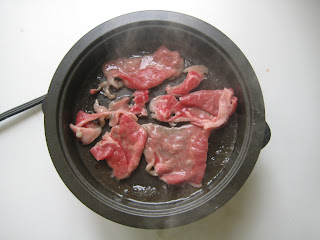 Traditionally, onions are browned in butter before the broth and other vegetables are added. And the meat actually goes in last.
Traditionally, onions are browned in butter before the broth and other vegetables are added. And the meat actually goes in last.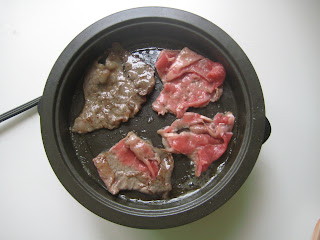 Here we are browning the meat first, almost like teppanyaki, a form of Japanese bbq where meats and vegetables are cooked on an iron griddle.
Here we are browning the meat first, almost like teppanyaki, a form of Japanese bbq where meats and vegetables are cooked on an iron griddle.
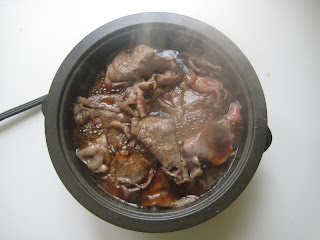 When the meat reaches medium-rare, that is when we add the sukiyaki sauce, which is a combination of soy sauce, sugar, and mirin (Japanese rice wine). Japanese markets usually have pre-mixed sukiyaki sauces.
When the meat reaches medium-rare, that is when we add the sukiyaki sauce, which is a combination of soy sauce, sugar, and mirin (Japanese rice wine). Japanese markets usually have pre-mixed sukiyaki sauces.
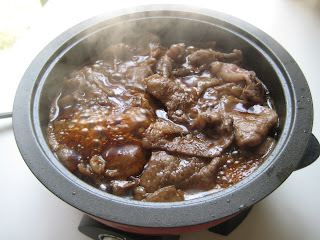 The meat is simmered in the sauce for just a moment, and then removed.
The meat is simmered in the sauce for just a moment, and then removed.
 In both the Osen-style and traditional sukiyaki, this meat (as well as the vegetables that are cooked later), are dipped in raw egg, and then eaten. I'm not too big on raw egg, so I just serve it over a steaming bowl of white rice.
In both the Osen-style and traditional sukiyaki, this meat (as well as the vegetables that are cooked later), are dipped in raw egg, and then eaten. I'm not too big on raw egg, so I just serve it over a steaming bowl of white rice.
 Nom.
Nom.
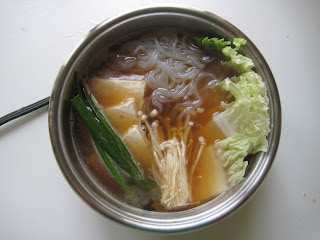 In Osen, the dashi broth is then added to the pot that the beef was cooked in, picking up all the meat juices and the remaining sauce. Unfortunately, my mini-teppan grill was a little shallow, so I had to mix a little of the broth in to pick up the sauce and juice, and then transfer that over to a taller soup pot.
In Osen, the dashi broth is then added to the pot that the beef was cooked in, picking up all the meat juices and the remaining sauce. Unfortunately, my mini-teppan grill was a little shallow, so I had to mix a little of the broth in to pick up the sauce and juice, and then transfer that over to a taller soup pot.
The vegetables are then added. The noodles on the top are yam noodles called shirataki noodles. They're much chewier than noodles such as ramen or udon.
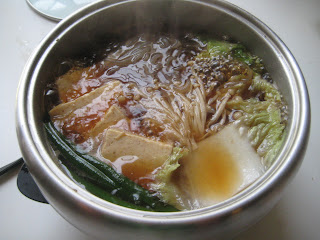 Covering and simmering lets all the flavors meld together. Especially in the tofu. In traditinal sukiyaki, the tofu is seared before stewing in the broth, and in Osen-style sukiyaki, the tofu is deep fried. These methods provide the tofu with a firmer texture on the outside, preventing the tofu from just falling apart as you try to pick it up. I just prefer straight up tofu, but it's all good~
Covering and simmering lets all the flavors meld together. Especially in the tofu. In traditinal sukiyaki, the tofu is seared before stewing in the broth, and in Osen-style sukiyaki, the tofu is deep fried. These methods provide the tofu with a firmer texture on the outside, preventing the tofu from just falling apart as you try to pick it up. I just prefer straight up tofu, but it's all good~
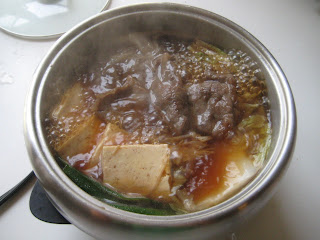 With some of my leftover meat added back in because it had cooled, this is what traditional sukiyaki would look like. The raw meat is added at the very end, after the broth and vegetables have simmered away, and cooked to a medium rare-state, and eaten immediately.
With some of my leftover meat added back in because it had cooled, this is what traditional sukiyaki would look like. The raw meat is added at the very end, after the broth and vegetables have simmered away, and cooked to a medium rare-state, and eaten immediately.
I personally prefer the Osen-style where the meat is cooked first, as it allows for a slight char on the outside of the meat, but it is a little troublesome, especially in my case, where I had to switch pots.
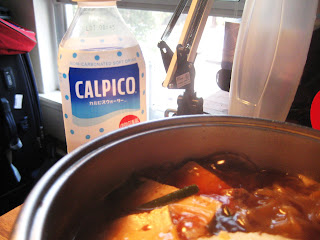 Regardless, it was awesome, especially with a bottle of Calpico~
Regardless, it was awesome, especially with a bottle of Calpico~
So I've come to the conclusion that, like many other things, I'm terrible with commitments. i.e. this blog. I don't even know what the last post was about.
Anyway, I'm working in Palo Alto for the summer, so I decided to get one of those desktop bonsai tree kits. Because when I think Palo Alto, goddammit, I think desktop bonsai tree kits.
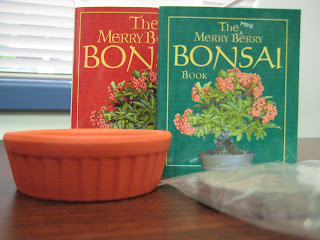 I'm sure you've seen these around at places like Borders, and thought, "oh this is neat." Then saw that it was $5.95 and though, "eh... it's not $5.95 neat though," and put it back on that spinning rack with all the other $5.95 novelty desktop items, like the tiny zen garden kit.
I'm sure you've seen these around at places like Borders, and thought, "oh this is neat." Then saw that it was $5.95 and though, "eh... it's not $5.95 neat though," and put it back on that spinning rack with all the other $5.95 novelty desktop items, like the tiny zen garden kit.
Well "fuck it," I said, "I'm in Palo Alto, the city of champions!" and splurged and got the merry berry version.
I bought it a week ago, and as per the instructions, refrigerated the seeds in a damp paper towel for seven days. And alas, the planting begins:
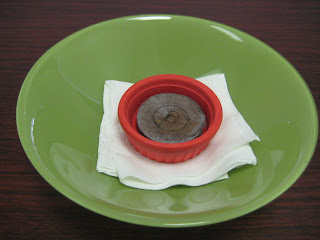 That pellet in the middle is dried dirt, about the size of an Oreo. The instructions say, "Slowly pour 32.oz of warm water on the pellet, until it expands." To put it in perspective, 32oz. is a little under 3 Coke cans worth of warm water.
That pellet in the middle is dried dirt, about the size of an Oreo. The instructions say, "Slowly pour 32.oz of warm water on the pellet, until it expands." To put it in perspective, 32oz. is a little under 3 Coke cans worth of warm water.
This is the pellet with a teaspoon of water on it.
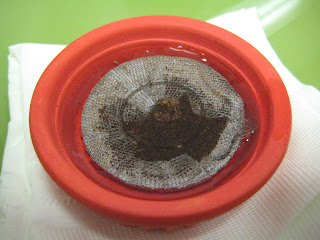 Needless to say, it took a while to get it to look like this:
Needless to say, it took a while to get it to look like this:
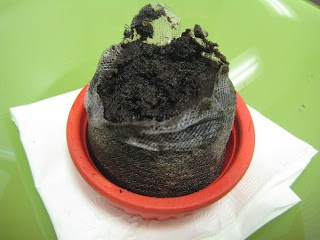 SEEDS.
SEEDS. And now it sits, basking in the sunlight of the only North facing window in my office.
And now it sits, basking in the sunlight of the only North facing window in my office. 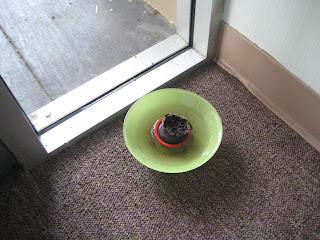 I figure this is the only way I'll regularly update. I'll post new pictures of my tree at least once a week hopefully (read "once a month").
I figure this is the only way I'll regularly update. I'll post new pictures of my tree at least once a week hopefully (read "once a month").
And this is what I made for dinner that day:
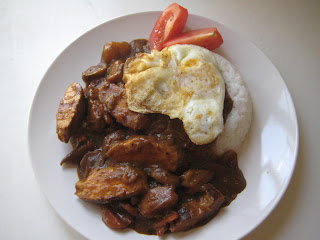 It's soy-marinated grilled chicken in vegetable curry.
It's soy-marinated grilled chicken in vegetable curry.